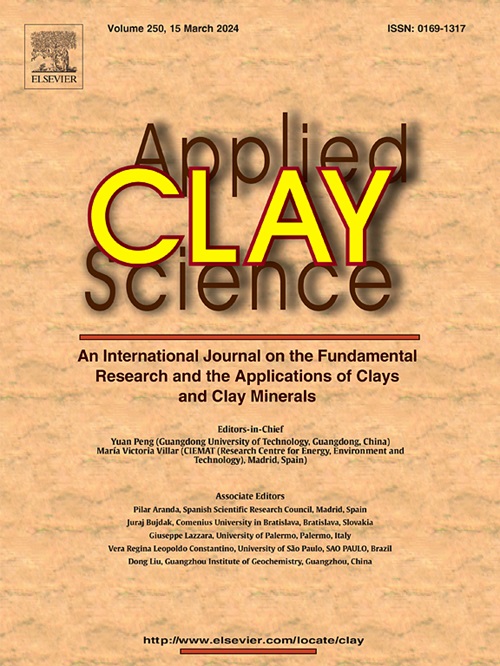Biogrouting and bio-clay grouting: Regulating biocement location with clay
IF 5.3
2区 地球科学
Q2 CHEMISTRY, PHYSICAL
引用次数: 0
Abstract
Biogrouting has been proposed for improving mechanical properties of soils and rocks, whose performance greatly depends on the location of biocement at pore-scale. To enhance the performance of biogrouting, many strategies were proposed, including the addition of assistants, controlling curing moisture degree, and flocculation of bacteria. Clay is one such assistant which has been proven to be effective, with an assumption of increasing active biocement, i.e. those located between soil particles. In this work, we employed microfluidics to directly observe whether clay minerals can certainly control the location of precipitates and how they function. First of all, the capacity of bentonite and kaolin for adsorbing bacteria were investigated. Then, the location of CaCO3 crystals with and without clay minerals were visually observed using microfluidics. Pore-filling ratios and CaCO3 ratios, which are closely related to permeability and strength of biocemented soils, were quantitatively analyzed from collected images. Finally, the effects of bentonite and kaolin and their dosages on the location of biocement were comprehensively discussed. The results demonstrated that the performance of bentonite and kaolin on adsorbing bacteria and regulating biocement location is distinct due to differences in the morphologies of clays. These findings can help us to improve biogrouting performance on soil stabilization and propose new strategies in various practical applications, such as CO2 sequestration, heavy metal remediation, and oil recovery enhancement, all with a foundational understanding of their mechanisms.
生物注浆与生物粘土注浆:用粘土调节生物水泥位置
生物灌浆已被提出用于改善土和岩石的力学性能,其性能在很大程度上取决于生物灌浆在孔隙尺度上的位置。为了提高生物注浆的性能,提出了添加助剂、控制养护含水率、细菌絮凝等策略。粘土就是这样一种已被证明是有效的助剂,它的假设是增加活性生物水泥,即位于土壤颗粒之间的生物水泥。在这项工作中,我们采用微流体直接观察粘土矿物是否确实可以控制沉淀的位置及其如何起作用。首先,研究了膨润土和高岭土对细菌的吸附能力。然后,利用微流体技术直观地观察了含粘土矿物和不含粘土矿物的CaCO3晶体的位置。对与生物胶结土的渗透性和强度密切相关的孔隙填充率和CaCO3比率进行了定量分析。最后,全面讨论了膨润土和高岭土及其用量对生物胶凝位置的影响。结果表明,膨润土和高岭土在吸附细菌和调节生物胶凝位置方面的表现是不同的,这是由于粘土的形态不同造成的。这些发现有助于提高生物灌浆对土壤稳定的效果,并在了解其机理的基础上,为各种实际应用提出新的策略,如二氧化碳封存、重金属修复和提高石油采收率。
本文章由计算机程序翻译,如有差异,请以英文原文为准。
求助全文
约1分钟内获得全文
求助全文
来源期刊

Applied Clay Science
地学-矿物学
CiteScore
10.30
自引率
10.70%
发文量
289
审稿时长
39 days
期刊介绍:
Applied Clay Science aims to be an international journal attracting high quality scientific papers on clays and clay minerals, including research papers, reviews, and technical notes. The journal covers typical subjects of Fundamental and Applied Clay Science such as:
• Synthesis and purification
• Structural, crystallographic and mineralogical properties of clays and clay minerals
• Thermal properties of clays and clay minerals
• Physico-chemical properties including i) surface and interface properties; ii) thermodynamic properties; iii) mechanical properties
• Interaction with water, with polar and apolar molecules
• Colloidal properties and rheology
• Adsorption, Intercalation, Ionic exchange
• Genesis and deposits of clay minerals
• Geology and geochemistry of clays
• Modification of clays and clay minerals properties by thermal and physical treatments
• Modification by chemical treatments with organic and inorganic molecules(organoclays, pillared clays)
• Modification by biological microorganisms. etc...
 求助内容:
求助内容: 应助结果提醒方式:
应助结果提醒方式:


